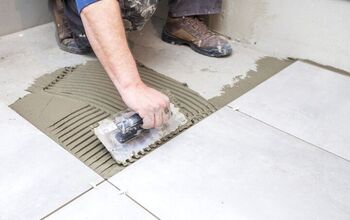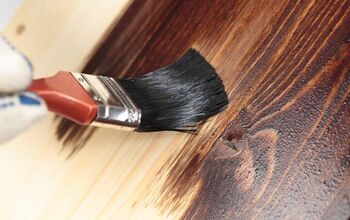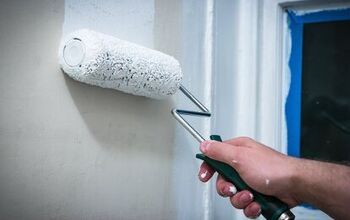How Long Does Wood Filler Take To Dry?

Wood filler is one of the more important tools you can use if you want to repair damaged plywood, remove scratches from your desk, and do mold remediation. Applying the filler is a breeze. You just need a spackle tool or a scraper to make sure it’s even. Drying, on the other hand, can be tricky. How long does wood filler take to dry?
Shallow repairs involving wood filler will only take 15 minutes to two hours to dry in most cases. Deeper fills can take as long as six hours before they are fully affixed to the wood. The best way to determine dry times is to look at guidelines for filler packaging. Along with dry time, the cure time will take additional hours. Set aside at least 24 to 48 hours for curing.
Wood fillers are meant to be a good tool for minor repairs. It’s not meant to be a full replacement for an entire board. With that said, let’s take a look at dry times.
Do You Need Handyman Services?
Get free, zero-commitment quotes from pro contractors near you.

Before You Begin: Remember Dry Time Factors
Before you assume that two hours can do the trick, you need to make sure that you are well-aware of the drying conditions. Here’s the scoop on dry time factors for wood fillers, and what you need to know:
- Depth. A 1/4 inch fill or less is considered to be shallow. You can usually expect this to be totally dry in an hour. You shouldn’t try to fill a crack or gap larger than 3/4 of an inch wide if you can avoid it. The deeper the crack, the longer the dry time will be.
- Filler Formula. Some brands are starting to roll out fast-drying fillers. They are going to dry quicker than a traditional filler would. It’s just that simple. Water-based fillers will take around half an hour for shallow repairs. Water takes slower to dry on the surface, but has a quicker full dry time. Oil will dry in as little as 20 minutes on the surface, but can take up to eight hours to dry.
- Humidity/Exposure To Water. Wet filler in a room that is clearly wet is going to take longer to dry than a piece of filled wood in an area that’s dry as a board.
How To Tell How Long Your Wood Filler Takes To Dry
Most of the time, the best way to figure out drying times is to look at the packaging. The packaging generally gives you guidelines on how long you should wait. Here’s what you need to know:
- Most fillers will take a maximum of two hours to fully dry if it’s a shallow gash filled by water-based filler. If you have an exceptionally deep gash you fixed, it can take as much as six to eight hours of dry time, depending on the filler. Oil fillers are notorious for long curing times, but have short dry times.
- Don’t assume the whole gash is dry if the surface is dry. While you can add another filler layer on top, you can’t work until the entire gash is dried and cured.
- The surface dries faster than the whole filled gash, and you should wait for the full cure time before you work on that wood. Most oil-based wood fillers will need between 12 to 48 hours to fully cure throughout the filling. With that said, you can usually add multiple thin layers on top of the first one as long as the surface has dried.
- Don’t assume the area is dry if it’s below the timeframe suggested on the box. Even if it’s a shallow nick you filled in, it’s not a smart move to assume it’s dry.
- Check for surface hardening if you aren’t sure if the surface is adequately dried yet. A simple poke of the finger is enough to give you a good idea if you need more. Most people just wipe the area down to see if stuff sticks.
What’s The Difference Between Drying And Curing?
Drying means that your wood filler will feel hard to the touch and can be filled over with a second or third layer. Dried but uncured filler will still have the same chemical makeup and may not be fully bonded to the wood. Curing means that your filler has settled in, that it has bonded to the wood, and has also changed in chemical makeup to act like part of the wood.
What Type Of Filler Is Better?
The best filler that you can get is the one that remains slightly moist and flexible after your filler has cured. This ensures that your filler won’t dry and crack later on and that you will be able to keep your wood filled in. Oil and silicone fillers, in particular, fit this bill.
How Can You Speed Up The Drying Process?
There are a couple of ways that you can help make the surface dry a little faster. With that said, it will still take a while to cure. These tips below can help you dry it a bit faster:
- Use a fan. Fans that blow air gently over the wood can speed up surface drying time significantly. If you don’t have a fan, use a folded piece of paper.
- Work in an area that has low humidity. You would be surprised at how much air moisture can impact the drying time. If you are working outside, it might be better to bring your work indoors so that it can dry adequately.
- Choose a fast-drying filler. Once again, personal choice can factor pretty big here. If you want to get a second layer fast, then you should stick to oil fillers. If you are not sure which filler is right for you, ask a hardware associate for help. That’s what they do!
- Make an effort to keep the area you want to be filled clean. You always get those warnings about keeping the area clean of debris, and that’s for good reason. Debris in the wood gap and surrounding area can make it harder for the area to actually dry. A quick vacuum or wipedown with a microfiber cloth can make all the difference.
Do You Need Handyman Services?
Get free, zero-commitment quotes from pro contractors near you.

Related Questions
What is the difference between wood putty and wood filler?
Wood putty is meant to be an addition to the top of the wood after the wood working has been finished. It’s there to smooth out nicks and cuts. Wood filler is applied inside nooks and crannies, and is designed to work from the inside out.When applied well, wood filler will actually protect, repair, and improve the integrity in your wood. Putty contains chemicals that can damage wood. If you are working with an heirloom antique or similar, you should avoid putty and opt for filler.
Can you use wood filler to affix two pieces of wood together?
Wood filler is not meant to be a replacement for mechanical affixture, nor is it a replacement for wood glue. Using filler in place of nails, screws, dowels, and glue will end up causing your woodworking project to fall apart.While filler does affix to wood, it is not meant to act like glue. You should never assume that wood filler will act like glue because the formula is too weak to hold up the opposing forces of weight. It’s there to patch up things, not keep things together.
What is used to fill in large gaps in wood?
Wood putty is actually your best option for filling in large gaps in wood, such as a chunk taken out of your wood flooring. To use it, squeeze (or spoon) out a large portion of the putty into the area with the gap. Then, use a paint scraper or squeegee to even out the putty into a smooth surface. Once it’s put in place, let it dry then sand it down.

Ossiana Tepfenhart is an expert writer, focusing on interior design and general home tips. Writing is her life, and it's what she does best. Her interests include art and real estate investments.
More by Ossiana Tepfenhart



























